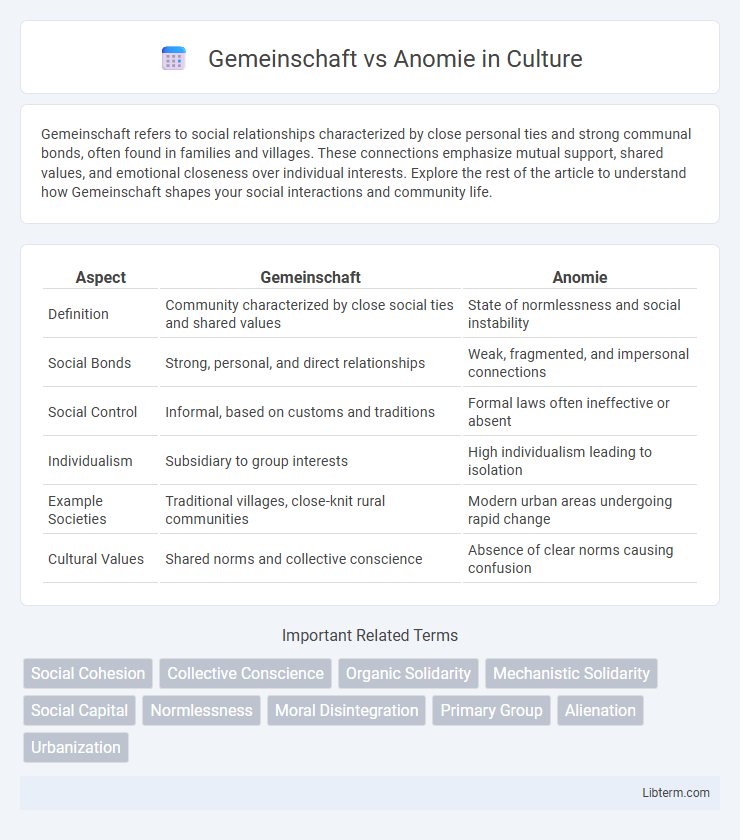Gemeinschaft refers to social relationships characterized by close personal ties and strong communal bonds, often found in families and villages. These connections emphasize mutual support, shared values, and emotional closeness over individual interests. Explore the rest of the article to understand how Gemeinschaft shapes your social interactions and community life.
Table of Comparison
| Aspect | Gemeinschaft | Anomie |
|---|---|---|
| Definition | Community characterized by close social ties and shared values | State of normlessness and social instability |
| Social Bonds | Strong, personal, and direct relationships | Weak, fragmented, and impersonal connections |
| Social Control | Informal, based on customs and traditions | Formal laws often ineffective or absent |
| Individualism | Subsidiary to group interests | High individualism leading to isolation |
| Example Societies | Traditional villages, close-knit rural communities | Modern urban areas undergoing rapid change |
| Cultural Values | Shared norms and collective conscience | Absence of clear norms causing confusion |
Defining Gemeinschaft: Foundations of Community
Gemeinschaft, defined by sociologist Ferdinand Tonnies, represents a form of social organization characterized by close-knit, personal relationships and shared values, often found in rural or traditional communities. It emphasizes gemeinschaftsgefuhl, or community feeling, where individuals experience a strong sense of belonging and mutual support. This foundational concept contrasts sharply with anomie, highlighting the significance of social cohesion and collective conscience in maintaining community stability and identity.
Understanding Anomie: A State of Social Breakdown
Anomie describes a condition of social instability resulting from a breakdown in the norms and values that guide individual behavior, leading to feelings of alienation and purposelessness. This concept, introduced by Emile Durkheim, highlights the consequences of rapid social change or economic upheaval that disrupt communal bonds and shared expectations. Understanding anomie is crucial for analyzing social disorders such as crime, suicide, and social fragmentation in modern societies.
Historical Origins: Tönnies and Durkheim’s Theories
Ferdinand Tonnies introduced the concepts of Gemeinschaft and Gesellschaft in the late 19th century to describe traditional, community-oriented social ties versus modern, impersonal associations. Emile Durkheim's theory of anomie, developed in the early 20th century, explained social instability resulting from a breakdown of norms during rapid social changes. Both perspectives historically emerged from concerns over social cohesion and the effects of modernization on communal bonds and individual behavior.
Key Characteristics of Gemeinschaft Societies
Gemeinschaft societies are characterized by close-knit social relationships, strong family ties, and a high degree of community cohesion, where individuals share common values and norms. These societies emphasize personal interactions and mutual dependence within small, often rural, communities. Social control is maintained through informal means such as tradition and social pressure rather than formal institutions.
Manifestations of Anomie in Modern Life
Anomie manifests in modern life through widespread social isolation, weakened community bonds, and increased feelings of purposelessness among individuals. Urbanization and rapid technological changes disrupt traditional social structures, leading to a decline in shared norms and values. This erosion of social cohesion contributes to higher rates of mental health issues, crime, and general societal instability.
Gemeinschaft vs Anomie: Core Differences
Gemeinschaft refers to social relationships characterized by close personal bonds, shared values, and strong community ties, often found in traditional societies. Anomie describes a state of normlessness where social bonds break down, leading to feelings of isolation and instability. The core difference lies in Gemeinschaft emphasizing cohesion and collective consciousness, while Anomie highlights social disintegration and the absence of shared norms.
Societal Transitions: From Community to Anomie
Gemeinschaft represents tightly-knit communities with strong social bonds and shared values, while anomie describes social instability caused by a breakdown of norms during societal transitions. Rapid urbanization and industrialization weaken traditional Gemeinschaft ties, leading to increased feelings of alienation and normlessness characteristic of anomie. This shift impacts social cohesion, influencing crime rates, mental health, and collective identity in modern societies.
Impacts on Individual Identity and Social Bonds
Gemeinschaft fosters strong social bonds and collective identity through intimate, face-to-face interactions characteristic of traditional communities, reinforcing a sense of belonging and shared values. In contrast, Anomie emerges in modern, impersonal societies where social norms weaken, leading to individual isolation, fragmented identities, and a decline in cohesive social relationships. This breakdown of social integration under Anomie increases feelings of alienation and diminishes the individual's connection to the larger community.
Overcoming Anomie: Strategies for Rebuilding Community
Overcoming anomie involves rebuilding social cohesion through community engagement, fostering shared values, and enhancing interpersonal connections to restore a sense of belonging. Strategies include creating inclusive social institutions, promoting civic participation, and encouraging collaborative activities that strengthen Gemeinschaft-like bonds. Empirical studies highlight how targeted community programs reduce feelings of isolation and improve social trust, effectively countering the social fragmentation characteristic of anomie.
Future Perspectives: Balancing Tradition and Modernity
Future perspectives on Gemeinschaft versus Anomie emphasize integrating the close-knit social bonds of Gemeinschaft with the dynamic, individualistic aspects of modernity to create resilient communities. Innovations in digital technology facilitate maintaining traditional communal values while adapting to rapid social changes, addressing risks of social isolation and normlessness characteristic of anomie. Sociologists predict that balancing these elements will be crucial for social cohesion in increasingly globalized and diverse societies.
Gemeinschaft Infographic

 libterm.com
libterm.com